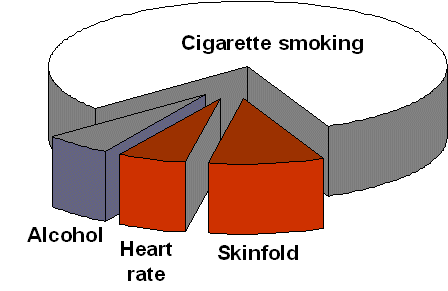Caloric intake and
high blood pressure
A caloric intake that is in excess of
the calories used during physical activity represents a crucial factor
promoting hypertension. Since a high proportion of hypertensive persons
is overweight, the designation "primary hypertension" is not justified
and the term "overweight hypertension" appears more appropriate. These
considerations represent also the basis for the generally accepted recommendation
of a weight reduction when high blood pressure has been diagnosed. The
blood pressure lowering effect of weight reduction is about 1 mm of Hg/kg
body weight. In animal experiments using radio telemetry we have shown
that an increased caloric intake is associated not only with a raised body
weight but also with a rise in heart rate and blood pressure (1). The increase
in heart rate and blood pressure is indicative of a raised sympathetic
activity originating from the brain. This so-called "hyperkinetic hypertension"
was reversible in animal experiments after changing the diet to a regular
diet. In humans, a similar hyperkinetic hypertension has been observed
particularly in young and young adult persons. This type of hypertension
is typically not treated since it rarely exceeds the blood pressure (140
mm Hg/90 mm Hg) which, according to common guidelines, would require pharmacological
treatment. This approach does not take into account that an established
high blood pressure is associated with the deleterious process of vascular
remodelling, e.g. increased media thickness, and more efforts should be
made to prevent the early remodelling process.
In view of many unsuccessful
efforts in reducing body weight of overweight or obese persons, an initial
rise in body weight should be avoided. One should also not argue that body
weight should be reduced only when signs of illness occur. A further misconception
refers to the commonly accepted view that disease relevant processes occur
only when the body mass index (BMI) is greater than 28.
As the number of overweight
persons in Westernized societies increases constantly, a genetic basis
of overweight appears unlikely while a genetic predisposition for overweight
should not be dismissed. A prerequisite for the manifestation of overweight
is - relative to the physical activity – a too high caloric intake. Generally
acceptable recommendations regarding the daily caloric intake appear not
to be justified, since there is an inter-individual variability in food
utilization and resting metabolism.
If one considers the
fact that the incidence of hypertension correlates with the rise in body
weight and appears to start with a body mass index of approx. 23, then
the necessity arises to prevent a slight body weight gain and, as an adjunctive
approach, to use pharmacological interventions which counteract the changes
in the neuroendocrine status of overweight persons.
The importance of overweight
for the development of hypertension has been documented in numerous studies.
In the Framingham Offspring Study, subscapular skinfold was, besides cigarette
smoking, the major predictor of hypertension in men (2). Skinfold thickness
can be measured by Harpenden calipers and is representative of body fat.
A fold of skin and subcutaneous tissue is pinched between the operator’s
thumb and forefinger (3).
In the Framingham Offspring
Study, also heart rate and alcohol consumed were independent predictors
of hypertension. Since a raised sympathetic activity is associated with
a higher heart rate, this association might not be unexpected. As regards
alcohol, it has been shown that it raises sympathetic outflow of the brain.

1. Rupp H, Maisch B: Radiotelemetric
characterization of overweight-associated rises in blood
pressure and heart rate.
Am J Physiol 1999;277:H1540-5
2. Garrison RJ, Kannel WB,
Stokes J, Castelli WP. Prev Med 1987;16:235-51
3. Jung RT: A colour atlas
of obesity 1990, Wolfe Medical Publications, London

